Adventure - Genres
Hottest on Streaming Today
Characteristic aspects of adventure films
The term "adventure film" is defined as a fictional genre in which one or more characters strive to accomplish a particular task or mission while overcoming a series of dangerous situations, which are mostly result of confrontations with enemies or the pitfalls of the remote, unexplored locations where the action often takes place. The protagonists of adventure films are often courageous and intrepid travellers and explorers, or virtuous protectors of justice, and in the history of cinema they have overwhelmingly been men, while women have been present as supporting characters, mainly because of romantic side-plots, and it’s only more recently that they have started to become protagonists themselves. These heroes are usually rewarded for their efforts with success in spite of all obstacles and hardships, thus demonstrating that good always triumphs over evil, altruism over selfishness, and protection of the innocent over violence and cruelty.
In many ways, adventure films resemble action films, but the latter focus more on fights, shootouts, chases, etc., while the former focus on the achievement of the goal set by the characters as such. Moreover, this division was practically non-existent until the 1960s, because although action scenes had appeared in films since the beginning of cinema, it was not until the 1970s that action film began to take shape as a separate genre. In addition, the adventure genre often overlaps with other genres, typically fantasy and westerns, but also historical films, dramas, comedies, thrillers, etc.
Frequent motifs of adventure films are organising expeditions to various exotic places (jungles, deserts, mountains...) and exploring them, searching for valuable treasures, artefacts and mythical places (ancient temples, lost civilizations, cities and islands), and working with the unknown, which is the main source of suspense along with the action sequences. Other prevalent themes can be the fight against injustice, rebellion and defiance against oppressors, defending the innocent and rescuing kidnapped or imprisoned victims. There are also special categories: pirate films are historical adventure films based primarily on pirate characters and involving themes of raiding and plundering, and films dealing with the struggle for survival, or survival thrillers, whose heroes find themselves in isolated or inhospitable locations, coping with feelings of loneliness, struggling to stay alive and attempting to return to civilization. Many adventure films are adaptations of literary works – the genre originally evolved from adventure novels – while others are inspired by real historical events and the protagonists are therefore real people living at the time. Another notable category is catastrophe films, but these are discussed as a separate genre.
Adventure films in the silent era
Adventure themes have featured in many films since the invention of cinema. A Trip to the Moon (1902), made by the French director and pioneer of film visual effects Georges Méliès, can be considered one of the first adventure films longer than a minute, and it is also the first sci-fi/fantasy film in history thanks to its plot about astronauts, their journey to the surface of the moon and their encounter with aliens. In the same year Méliès made an adaptation of Gulliver's Travels, Gulliver's Travels Among the Lilliputians and the Giants, followed up by the adaptation of Verne’s 20,000 Leagues Under the Sea (1907), and in 1912 he returned to the theme of exploration in The Conquest of the Pole, all of which again contained strong fantasy elements. Other early European films include the French Fan Fan the Tulip (1925) and the Italian The Extraordinary Adventures of Saturnino Farandola (1913), whose protagonist, raised by monkeys, had adventures under the sea, in the air and across continents. Adventure films were also made in Great Britain (The Laughing Cavalier, 1917) and in the German Empire (Fritz Lang's two-part fantasy film Die Nibelungen from 1924), while She (1925), about heroes searching for an underground mythical city that gives immortality, was a British-German co-production.
The first pirate film, The Pirate's Gold (1908), directed by D. W. Griffith, was made in America, and of course others soon followed. Robin Hood (1912) was the first film to bring the famous Sherwood outlaw to the silver screen, with him and his band taking from the rich and giving to the poor, and there were also adaptations of novels such as Ivanhoe (1913), 20,000 Leagues Under the Sea (1916), The Three Musketeers (1916), Tom Sawyer (1917), The Last of the Mohicans (1920), Treasure Island (1920), and The Lost World (1925), in which an adventurous expedition makes a journey into a territory with surviving dinosaurs. In the adventure-romance film Don Juan (1926) the main character was a well-known seducer of women, but adventure motifs also began to appear in slapstick films like The General (1926), and we can also see the first films featuring Tarzan, the lord of the apes: Tarzan of the Apes (1918), The Revenge of Tarzan (1920) and Tarzan and the Golden Lion (1927). Ben-Hur: A Tale of the Christ (1925) was a major event. It was a lavish, technically groundbreaking and very expensive historical adventure film about a Jewish prince combined with the story of Jesus Christ.
The General (1926)
Photo © United Artists
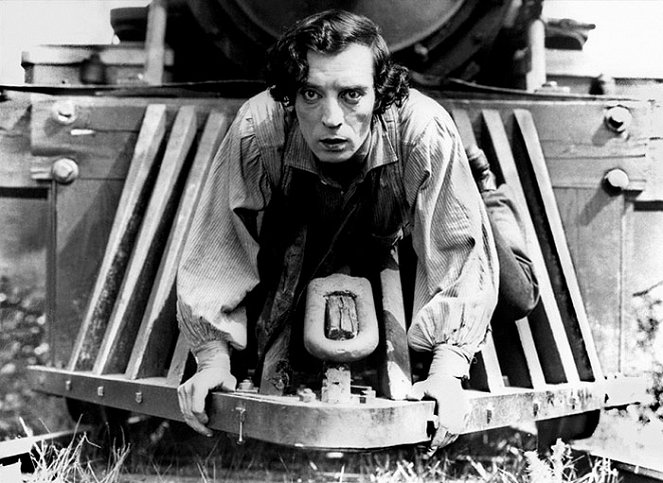
Swashbuckling films of the 1920s and 30s
A type of adventure film that became popular in America from the 1920s are the so-called “swashbuckling films”. They were adventure-action films with sword fights and valiant heroes who rescued damsels in distress and settled scores with their enemies in duels with swords or cutlasses. Often inspired by folk heroic myths and pirate stories or characters from classic literature, they became a success with audiences thanks to the attractive combination of entertaining adventure action with historical romance. The defining film of this sub-genre was The Mark of Zorro (1920), starring Douglas Fairbanks as the masked vigilante, who later went on to star in the equally notable adventure films The Three Musketeers (1921), Robin Hood (1922), The Thief of Baghdad (1924), Don Q Son of Zorro (1925), The Black Pirate (1926), and The Iron Mask (1929).
In the 1930s, when sound was already the norm, Fairbanks's successor was Errol Flynn, who starred in Captain Blood (1935), The Adventures of Robin Hood (1938) and The Sea Hawk (1940). Zorro appeared again in The Mark of Zorro (1940), this time played by Tyrone Power. Other representatives of the swashbuckling genre were The Count of Monte Cristo (1934), The Prisoner of Zenda (1937), The Man with the Iron Mask (1939), and the British The Scarlet Pimpernel (1934). Back in the silent era, serialised adventure films were also popular and were the de facto predecessors of TV series. One of the first in this respect was the 20-part series The Perils of Pauline (1914), about a damsel in distress who finds herself in a different life-threatening situation at the end of every episode. The number of these serialised productions would increase significantly later, with many of them also featuring well-known heroes from adventure novels and swashbuckling films, such as The Son of Tarzan (1920), The Adventures of Tarzan (1921), The Adventures of Robinson Crusoe (1922), Tarzan the Tiger (1929), The Three Musketeers (1933) and Zorro Rides Again (1937).
Captain Blood (1935)
Photo © Warner Bros. Pictures
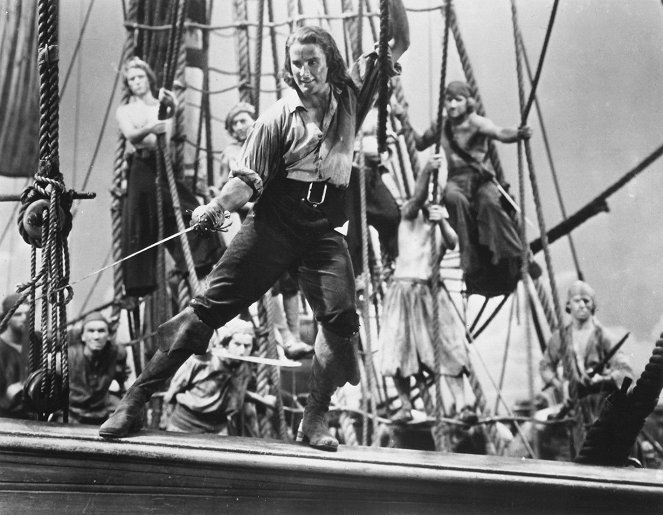
King Kong and other early sound adventure films
1933 saw the premiere of King Kong, where a group of filmmakers arrive on a mysterious island to shoot a film and they encounter a giant gorilla and, after successfully capturing it, transport it to New York. It would become one of the most famous films in history and has been remade several times. The new Tarzan films, such as Tarzan the Ape Man (1932), Tarzan and His Mate (1934) and Tarzan Escapes (1936), were also very successful. This series continued to thrive in the 1940s and 50s, with nearly twenty sequels, most of them starring first Johnny Weissmuller and then Lex Barker.
The aforementioned She, from 1925, got a remake in 1935 that revived the theme of the expedition to an underground city, while the heroes of Frank Capra’s Lost Horizon (1937) went in search of the legendary kingdom of Shangri-La. Adventure expeditions were also popularised by The Adventures of Marco Polo (1938) and Stanley and Livingstone (1939), and there where other adaptations of adventure novels that made a significant impact, among them the pirate novel Treasure Island (1934), The Call of the Wild (1935) set in the Alaskan goldfields, another version of The Three Mesquiteers (1936), and King Solomon's Mines (1937), which dealt with the search for diamond mines in South Africa.
Frank Lloyd’s adventure film Mutiny On the Bounty (1935), inspired by a real-life mutiny on a British Navy ship against a sadistic captain, won the 1936 Academy Award for Best Picture, turning in one of eight nominations. Other films that competed for the same award include Henry Hathaway's The Lives of a Benghal Lancer (1935), a seven-Oscar-nominated story about British soldiers fighting rebels in colonial India, Victor Fleming's Captains Courageous (1937), in which a boy from a wealthy background finds himself in the company of fishermen, Howard Hawks's Only Angels Have Wings (1939), about reconnaissance pilots, and a new version of The Thief of Baghdad (1940), an American-British co-production that won a total of three Oscars.
King Kong (1933)
Photo © RKO Radio Pictures
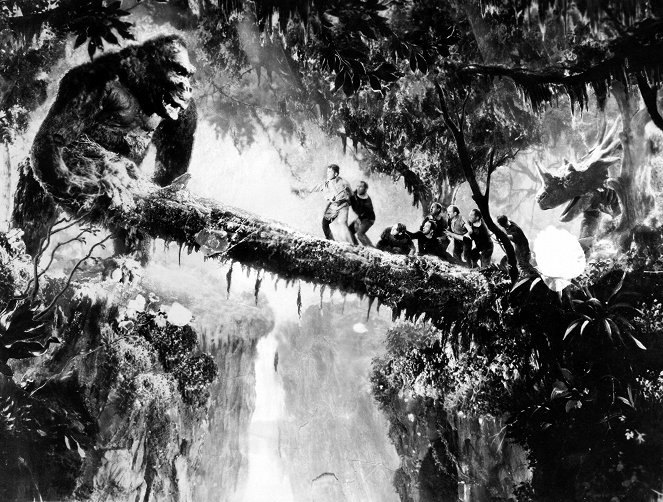
Fan-Fan the Tulip and other adventure films of the 1940s and 50s
In the 1940s and 50s, Hollywood adventure films often took the form of westerns, which dominated all other productions at the time, but a large number of war and detective films were also made. The techniques of the western and the adventure film were successfully combined especially in John Huston's three Oscar-winning The Treasure of the Sierra Madre (1948), which dealt with the corrupting influence of discovered gold on a trio of greedy and mutually suspicious drifters and gold diggers. Shortly after, Huston made the four Oscar-nominated The African Queen (1951), the story of two contrasting protagonists played by Katharine Hepburn and Humphrey Bogart, who are forced to survive together in the African jungle, and became a pioneer for many later adventure romances. Even more successful in terms of awards was Michael Anderson's Around the World in 80 Days (1956), which won five Oscars. As far as other notable adaptations of novels go, it’s impossible to forget 20,000 Leagues Under the Sea (1954), directed by Richard Fleischer, with two Oscars to his credit and starring Kirk Douglas; Moby Dick (1956), with Gregory Peck as an obsessed whaling ship captain; and the seven Oscar-winning The Bridge on the River Kwai (1957), directed by David Lean and starring Alec Guinness and William Holden as prisoners of war.
The Three Musketeers (1948), Adventures of Don Juan (1948), Cyrano de Bergerac (1950), about a big-nosed swordsman in love, and Scaramouche (1952), set during the Great French Revolution, revived the classic swashbuckling literary stories. There were also remakes of King Solomon's Mines (1950), which won two Oscars, and The Prisoner of Zenda (1952). The number of pirate and sailor films also increased with, for instance, The Black Swan (1942), the three Oscar-nominated Reap the Wild Wind (1942), Frenchman's Creek (1944), Captain Kidd (1945), Sinbad the Sailor (1947), the musical The Pirate (1948), Treasure Island (1950), based on the famous book, the action-pirate female heroines of Anne of the Indies (1951), Against All Flags (1952), the comedy The Crimson Pirate (1952), The Buccaneer (1958), and the animated Peter Pan (1953). The 7th Voyage of Sinbad (1958), inspired by Greek mythology, was co-produced by the USA and Great Britain and would be later followed by the sequels The Golden Voyage of Sinbad (1973) and Sinbad and the Eye of the Tiger (1977). Also worth mentioning are The Spirit of St. Louis by Billy Wilder (1957) and The Vikings by Richard Fleischer (1958).
In France, The Three Musketeers (1953) and The Count of Monte Cristo (1954) were co-produced with Italy. Fan-Fan the Tulip (1952), in which Gérard Philipe plays the role of a spontaneous romantic hero who was falsely predicted he would marry the king's daughter before joining the army, and The Hunchback of Paris (1959), in which Jean Marais, as a brave nobleman, takes in the young daughter of his murdered friend, were both major hits. Director Henri-Georges Clouzot succeeded with his adventure thriller The Wages of Fear (1953), which depicted the story of truck drivers transporting a dangerous load of nitroglycerin through the Latin American jungle, while Spanish director Luis Buñuel made the acclaimed Mexican adaptation of Daniel Defoe's Robinson Crusoe (1954). The 1950s saw a wave of adventurous samurai films in Japan, and their leading figure, director Akira Kurosawa, became famous for the likes of Seven Samurai (1954), Yojimbo (1961) and Sanjuro (1962), all starring his court actor Toshiro Mifune.
The 7th Voyage of Sinbad (1958)
Photo © Morningside Productions
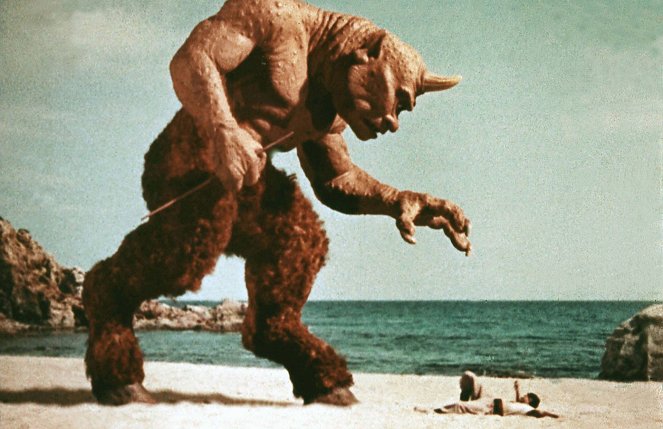
Historical epics and other adventure films of the 1960s
In 1956, director Cecil B. DeMille's remade his own historical film, The Ten Commandments, the seven Oscar-nominated biblical story of Moses, portrayed by Charlton Heston, who would go on to star in William Wyler's Ben-Hur (1959), a remake of the namesake 1925 film, which won a record eleven Academy Awards. They were followed by Stanley Kubrick's Spartacus (1960), which won four Oscars and starred Kirk Douglas as the leader of a slave revolt in ancient Rome. Another adventure epic was David Lean's Lawrence of Arabia (1962), which won seven golden statuettes and starred Peter O'Toole as a British officer who managed to unite the Arab tribes against the Turks during the First World War. The historical theme of the defence of the Sudanese capital against Islamic invaders was the focus of the British film Khartoum (1966), and even more ancient history was the subject of Jason and the Argonauts (1963), which drew on ancient myths. The Great Escape by director John Sturges (1963), set in World War II and based on the escape from a German prison camp of Allied soldiers led by Steve McQueen, can also be considered an adventure film.
Mutiny on the Bounty (1962), directed by Carol Reed and Lewis Milestone and starring Marlon Brando as an officer leading a mutiny against a despotic captain, was nominated for seven Academy Awards. Robert Aldrich's The Flight of the Phoenix (1965), about a group of castaways surviving after a plane crash in the middle of the Sahara desert, was also up for two golden statuettes. Peter Brook's Lord of the Flies (1963), about the survival of a group of children after a plane crash on a deserted island, was thematically similar. Howard Hawks's comedy-adventure Hatari! (1962), about hunters capturing wild animals for zoos in Africa, also made a significant impact. Other popular films were The 3 Worlds of Gulliver (1960), the dinosaur-themed One Million Years B.C. (1966) and The Valley of Gwangi (1969), both of which were made with special effects artist Ray Harryhausen. Several films dealt with Arthurian legends, such as the animated The Sword in the Stone (1963), the British Lancelot and Guinevere (1963), and the three Oscar-winning musical Camelot (1967). The story of the 1935 film She was revived in the British film She (1965), later followed by a sequel, The Vengeance of She (1968).
A long-running phenomenon in Europe was the French co-production of an historical adventure-romance film series starring Michèle Mercier and Robert Hossein, telling the story of a noblewoman married to a wealthy count: Angélique (1964), Angelique: The Road to Versailles (1965), Angelique and the King (1966), Indomitable Angélique (1967), and Angelique and the Sultan (1968). There were also a number of French swashbuckling films co-produced with Italy and Spain, such as The Fighting Musketeers (1961), Vengeance of the Three Musketeers (1961) and The Iron Mask (1962), while the Italian film Revenge of the Musketeers (1963), and the Spanish co-production Scaramouche (1963) were made on a similar vein. French adventure-comedy films with Jean-Paul Belmondo, such as That Man from Rio (1964) and Up to His Ears (1965), were also popular.
The Flight of the Phoenix (1965)
Photo © Twentieth Century-Fox Film Corporation
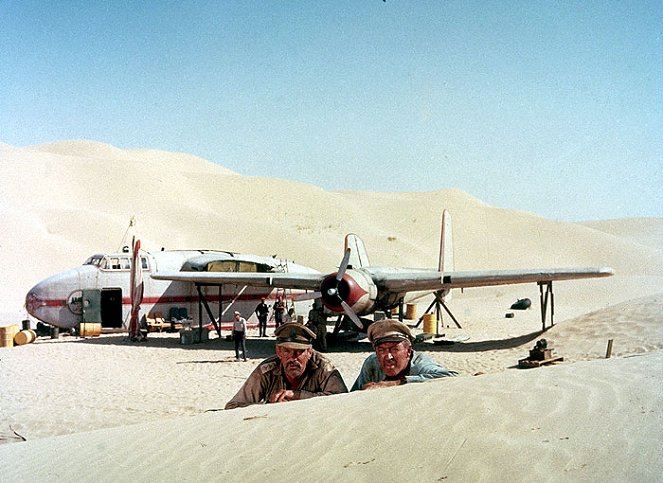
Jaws and other adventure films from the 1970s
At the turn of the 1960s and 70s, a new generation of filmmakers entered the world of American cinema and gave birth to the era of New Hollywood, but they didn’t give much space for adventure films, preferring instead other genres and films with more artistic ambitions. However, one of the highest-grossing films of the 1970s was Steven Spielberg's Jaws (1975), which revolved firstly around a giant man-eating shark threatening the residents and visitors of a beach resort, and secondly around the group of daredevils hired to eliminated it. This critically acclaimed adventure thriller elevated a B-movie beast-hunting premise to a masterpiece, won three Oscars, and its late-June release ushered in the era of the summer blockbusters. Another film that made history was the co-production The Three Musketeers (1973), directed by Richard Lester, considered by many to be the best adaptation of Dumas's classic novel, and it was soon followed by the sequel The Four Musketeers: Milady’s Revenge (1974). The Italian-French Zorro (1975), starring Alain Delon, also drew on the tradition of swashbuckling films.
Werner Herzog's German film Aguirre, the Wrath of God (1972), about an expedition in the South American jungle led by a conquistador obsessed with finding the mythical golden city of El Dorado, was visionary. In 1976, John Guillermin directed a new version of the legendary King Kong. Actor Sean Connery shone in the adventure films The Man Who Would Be King (1975), The Wind and the Lion (1975) and Robin and Marian (1976). There were also several films that dealt with the theme of survival in the wilderness, such as Man in the Wilderness with Richard Harris (1971), Jeremiah Johnson with Robert Redford (1972) and the adventure thriller Deliverance (1972), whose protagonists come into conflict with some rugged mountain men on a trip down a wild river, while Treasure Island with Orson Welles (1972) and Swashbuckler (1976) dealt with pirate themes. The legends of King Arthur inspired the French-Italian Lancelot of the Lake (1974), while the British comedy Monty Python and the Holy Grail (1975) played with them in a parodic way. Director and animator Ralph Bakshi created several animated fantasy-adventure films for adults, including Wizards (1977), The Lord of the Rings (1978), and Fire and Ice (1983).
Jaws (1975)
Photo © 1975 Universal Pictures
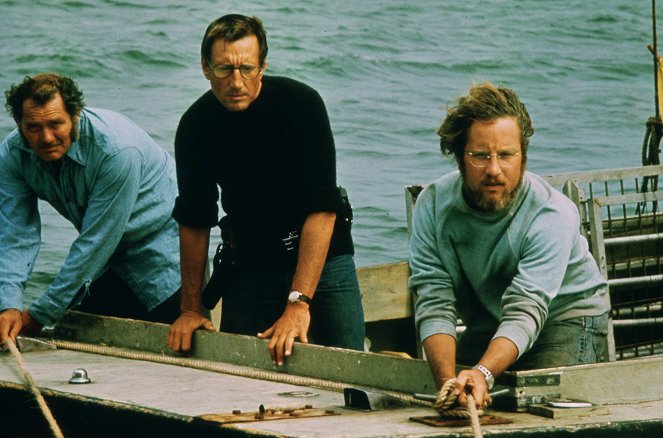
Indiana Jones and other adventure films from the 1980s
John Boorman's Excalibur (1981) contributed to the theme of Arthurian legends, while in the same year Desmond Davis' Clash of the Titans (1981) was inspired by ancient myths, and a year later John Milius made Conan the Barbarian (1982), which was inspired by a series of fantasy stories. These three films, considered the cornerstones of modern fantasy adventure, inspired many other filmmakers and would be followed by many later genre-related films. Following in the footsteps of Conan the Barbarian was the sequel Conan the Destroyer (1984) and also Red Sonja (1985). Russell Mulcahy's Highlander (1986), achieved cult status with the story of immortal warriors settling scores across several centuries, while adventure fairy tale films such as Ladyhawke by Richard Donner (1985), The Princess Bride by Rob Reiner (1987) and Willow by Ron Howard (1988) also enjoyed success. The genre of adventure fantasy films was further developed by Ridley Scott's Legend (1985), Jim Henson's Labyrinth (1986), Terry Gilliam's Time Bandits (1981) and The Adventures of Baron Munchausen (1988), and Wolfgang Petersen's The NeverEnding Story (1984).
Steven Spielberg's Raiders of the Lost Ark (1981) was another major contribution to the adventure film genre, introducing the world to the character of a fearless, whip-wielding archaeologist and adventurer played by Harrison Ford. The story, in which the protagonist fight Nazis and searches for the mythical Ark of the Covenant, served as an homage to the adventure films and serials of the 1930s and was followed by several sequels. In Indiana Jones and the Temple of Doom (1984), the plot revolved around sacred stones and followers of a dangerous religious cult, while the third instalment, Indiana Jones and the Last Crusade (1989), was essentially a quest for the Holy Grail. The fourth instalment, Indiana Jones and the Kingdom of the Crystal Skull (2008), was released almost twenty years later, but this time plot was moved from the 1930s to the 50s, and besides the adventurous templates, it was also inspired by science fiction twenty years younger and replaced Nazis with Soviets. The success of the Indiana Jones franchise was followed by, among others, Robert Zemeckis' adventure-comedy-romance Romancing the Stone (1984) and its sequel The Jewel of the Nile (1985), starring Michael Douglas and Kathleen Turner.
The musical The Pirates of Penzance (1983), the British comedy Yellowbeard (1983) and Roman Polanski's Pirates (1986) tried in vain to revive the pirate genre. A pirate treasure was also a feature in Richard Donner's family adventure film The Goonies (1985), in which a group of boys sets out to find one in underground caves. The atmosphere of boyhood adventure was also conveyed by Rob Reiner's Stand by Me (1986), a film about the journey of four friends in search of a corpse. Greystoke: The Legend of Tarzan, Lord of the Apes (1984) and Runaway Train (1985) were both up for three Oscars; the British-French historical film The Mission (1986), set in the Spanish and Portuguese colonies of South America, won only one of its seven nominations, and the co-production Quest for Fire (1981), which featured prehistoric people, also earned one statuette. Other notable adventure films of the 1980s include the comedy Caveman (1981), The Bounty (1984), about the famous mutiny, and The Mosquito Coast (1985), about an American family that leaves the city under the guidance of their obsessive, civilization-hating father and begins a new, troubled life in the middle of the jungle.
Indiana Jones and the Last Crusade (1989)
Photo © 1989 Lucasfilm Ltd.
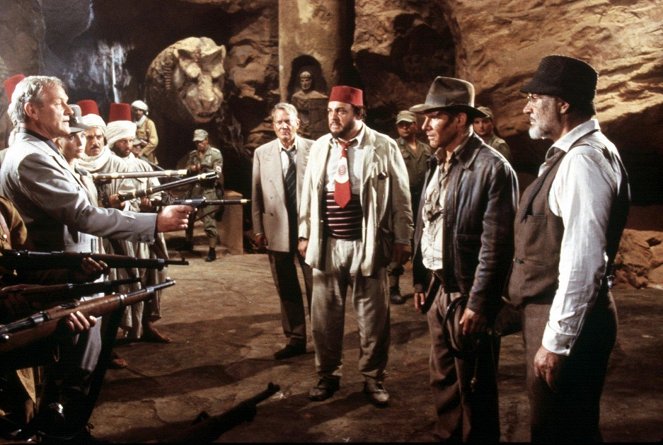
Jurassic Park and other adventure films from the 1990s
Right at the beginning of the 1990s, Kevin Costner managed to push his anti-western directorial debut Dances with Wolves (1990), a monumental adventure about an American soldier who wins the trust of an Indian tribe. This acclaimed film was a huge hit and won seven Academy Awards, including Best Picture. A year later, Costner also succeeded in the lead role in Robin Hood: Prince of Thieves (1991), which continued the tradition of swashbuckling films together with the French Cyrano de Bergerac (1990), starring Gérard Depardieu, and Antonio Banderas’s The Mask of Zorro (1998), whose popularity led to a sequel, The Legend of Zorro (2005). Steven Spielberg's Jurassic Park (1993), was technically revolutionary with a plot revolving around the creation of a nature reserve with cloned dinosaurs. It was a sci-fi adventure that believably combined computer effects with animatronics and became the highest-grossing film in history at the time, leading to two sequels, The Lost World: Jurassic Park (1997) and Jurassic Park III (2001).
First Knight (1995) offered a variation on the Arthurian story, the fairytale Dragonheart (1996) was a welcome addition to the adventure fantasy genre, and Egyptian mythology was revived by Stephen Sommers's The Mummy (1999) and its two sequels. There were also adventure films with a mountaineering theme (K2, 1991) and films that combined the genre with parody (Robin Hood: Men in Tights, 1993), thriller (The River Wild, 1994), western comedy (Maverick, 1994) and romantic comedy (Six Days Seven Nights, 1998). Films like Waterworld (1995) or The Postman (1997) had post-apocalyptic settings, while Alive (1993) and The Edge (1997) were linked by the survival of several characters after a plane crash in the mountain wilderness. There were also several new adaptations of classic adventure novels, including The Three Musketeers (1993), The Jungle Book (1994), Robinson Crusoe (1997) and The Man in the Iron Mask (1998). Famous literary adaptations were also used as the basis for the films Lord of the Flies (1990), White Fang (1991), White Squall (1996) and the much praised The Last of the Mohicans by Michael Mann (1992), set in the period of the French and English battles with the Indians during the settlement of North America. Medicine Man with Sean Connery (1992), The Ghost and the Darkness (1996) with Michael Douglas and Val Kilmer, Seven Years in Tibet with Brad Pitt (1997) and the film series The Adventures of Young Indiana Jones (since 1994) was based on the TV series.
Steven Spielberg joined the attempts to revive the pirate genre with Hook (1991), which delved into the world of Peter Pan, but Renny Harlin's extremely unsuccessful Cutthroat Island (1995) definitively buried the effort. The last contribution to the pirate genre in the 1990s was the family film Muppet Treasure Island (1996), which starred the famous puppets. Other family adventure films worth highlighting include Free Willy (1993), about the friendship between a killer whale and a boy who seeks to set it free, Homeward Bound: The Incredible Journey (1993), featuring two dogs and a cat, Jumanji (1995), named after a mischievous board game that creates obstacles for its players in the real world, and the French film Asterix and Obelix vs. Caesar (1999), based on the popular comic book. Also worth mention are The Adventures of Huck Finn (1993), Iron Will (1994), Black Beauty (1994), Fly Away Home (1996), George of the Jungle (1997), Grizzly Falls (1999), and Stuart Little (1999), as well as animated films such as Anastasia (1997), The Magic Sword: Quest for Camelot (1998) a The Iron Giant (1999), and Disney’s DuckTales The Movie – Treasure of the Lost Lamp (1990), Aladdin (1992), The Lion King (1994), Pocahontas (1995), Hercules (1997), Mulan (1998), and Tarzan (1999).
Robin Hood: Prince of Thieves (1991)
Photo © Warner Bros. Pictures
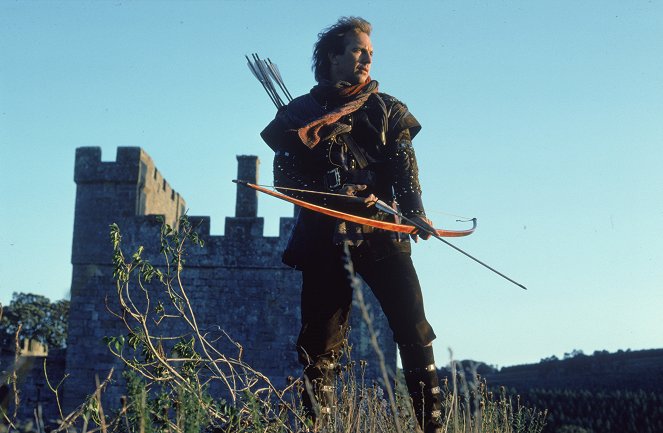
Pirates of the Caribbean and other adventure films after 2000
The rise of digital technology led to the gradual decline of classic adventure films, which were replaced by science fiction and fantasy films, as well as action and superhero films. The fantasy-adventure film genre was greatly revived by the extraordinary success of Peter Jackson's The Lord of the Rings trilogy (2001, 2002 and 2003), the third instalment of which won eleven Academy Awards and became the first fantasy film to win the Oscar for Best Picture. It was followed by other adaptations of fantasy-adventure novels such as Eragon (2006), The Golden Compass (2007), Stardust (2007), John Carter (2012), The BFG (2016), and The Chronicles of Narnia film series (2005, 2008 and 2010). Family films such as Peter Pan (2003), Bridge to Terabithia (2007), The Spiderwick Chronicles (2008), City of Ember (2008), and Pan (2015), as well as animated films such as Beowulf (2007), How to Train Your Dragon (2010) and Brave (2012) also fell into the same genre. Some adventure films based on Greek myths such as Troy (2004), Clash of the Titans (2010) and Hercules (2014) also joined the fantasy genre. Gore Verbinski's profitable fantasy-adventure Pirates of the Caribbean: The Curse of the Black Pearl (2003) finally succeeded in reviving the seemingly dead pirate genre, and its acclaim gave rise to a popular franchise with episodes subtitled Dead Man's Chest (2006), At World's End (2007), On Stranger Tides (2011), and Dead Men Tell No Tales (2017).
Right at the beginning of the new millennium, there were several historical-adventure films that made a significant impact, notably the five Oscar-winning Gladiator (2000) and Kingdom of Heaven (2005), both directed by Ridley Scott, as well as Edward Zwick's The Last Samurai (2003) and Oliver Stone's Alexander (2004). Several long-established stories were given a new look: King Arthur by Antoine Fuqua (2004), Peter Jackson's three Oscar-winning King Kong (2005), Ridley Scott's Robin Hood (2010), and David Yates's The Legend of Tarzan (2016), all of which were more or less classically rendered, while their more recent variations like Kong: Skull Island (2017), King Arthur: Legend of the Sword (2017), and Robin Hood (2018) took a more modern, unconventional, and innovative approach. The theme of a park with dinosaurs was revisited in Jurassic World (2015), a new wave of popularity was sparked by Disney’s live-action remakes of its animated adventure films: The Jungle Book (2016), Aladdin (2019), The Lion King (2019), and Mulan (2020), and James Cameron's fantasy/sci-fi adventure film Avatar (2009) was an unprecedented success, becoming the highest-grossing film in history for a long time.
Pirates of the Caribbean: The Curse of the Black Pearl (2003)
Photo © 2003 WALT DISNEY Pictures
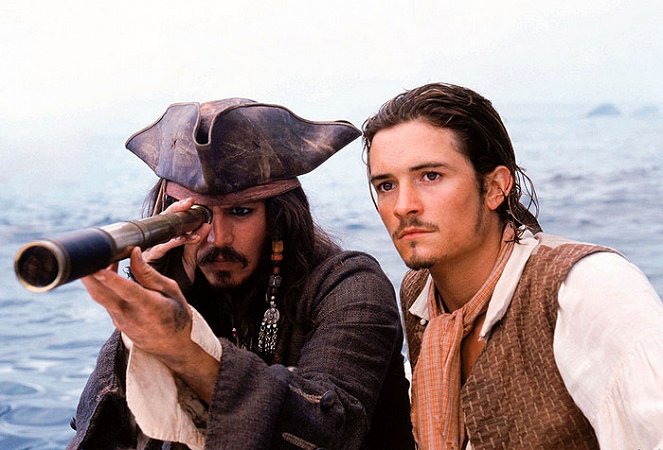
The survival motif and other adventure films after 2000
The success of Robert Zemeckis's Cast Away (2000), whose protagonist, played by Tom Hanks, became a modern-day Robinson Crusoe, led to a boom in films with survivalist themes, and the characters in The Snow Walker (2003), Touching the Void (2003), Into the Wild (2007), 127 Hours (2010, six Oscar nominations), The Grey (2011), The Revenant (2015, three Oscars out of twelve nominations), The Mountain Between Us (2017), Jungle (2017), and Arctic (2018), as well as in the mountaineering films Vertical Limit (2000), North Face (2008), and Everest (2015) all found their lives in danger in inhospitable conditions. There were also several films about survival on a desolate sea, whether on a boat (Life of Pi, 2012, All Is Lost, 2013 or Adrift, 2018) or without it (Open Water, 2003). The heroes of Rabbit Proof Fence (2002) and The Way Back (2010) experienced haunting journeys to different places, and the theme of the struggle for survival was also set in a flooding cave (Sanctum, 2011), in the freezing waters of the Arctic Ocean (The Deep, 2012), in outer space (Gravity, 2013) or on the surface of Mars (The Martian, 2015). Other films about heroes' confrontations with animals, such as sharks (2010's The Reef, 2016's The Shallows) or alligators (2019's Crawl), also fell into the same category.
A Knight's Tale (2001) came up with an unconventional version of the Middle Ages, Casanova (2005), Ben-Hur (2016) and The Mummy (2017) were dusted off, and Terry Gilliam's The Man Who Killed Don Quixote (2018) presented a peculiar variation on the Castilian knight. The motif of adventurous expeditions returned with Kon-Tiki (2012), The Lost City of Z (2016) and the family movies Journey 2: The Mysterious Island (2012) and Dora and the Lost City of Gold (2019). Peter Weir's ten Oscar-nominated naval adventure Master & Commander: The Far Side of the World (2003) revisited the Napoleonic Wars, while the plot of the six Golden Globe-nominated Captain Phillips (2013), about a cargo ship ambushed by Somali pirates, was set in the present day. Adventure films such as Lara Croft: Tomb Raider (2001), Prince of Persia: The Sands of Time (2010), Assassin's Creed (2016), and Tomb Raider (2018) were based on popular computer games, while Jumanji: Welcome to the Jungle (2017) was inspired by video games.
There were also adaptations of classic adventure novels, including Around the World in 80 Days (2004), Journey to the Center of the Earth (2008), In the Heart of the Sea (2015), and The Call of the Wild (2020), as well as swashbuckling films such as the traditionally conceived The Count of Monte Cristo (2002) and the steampunk-styled The Three Musketeers (2011). Other adventure films also worth mentioning include The Beach (2000), Sky Captain and the World of Tomorrow (2004), National Treasure (2004), Blood Diamond (2006), Apocalypto (2006), and The Lone Ranger (2013), as well as family adventures such as Belle and Sebastian (2013), Heidi a Brothers of the Wind (2015) animated adventures such as Dinosaur (2000), Ice Age (2002), Treasure Planet (2002), Finding Nemo (2003), The Adventures of Tintin (2011), The Pirates! In an Adventure with Scientists! (2012), The Croods (2013), Long Way North (2015), Kubo and the Two Strings (2016), Moana (2016), and The Croods: A New Age (2020).
Cast Away (2000)
Photo © 2000 20th Century Fox
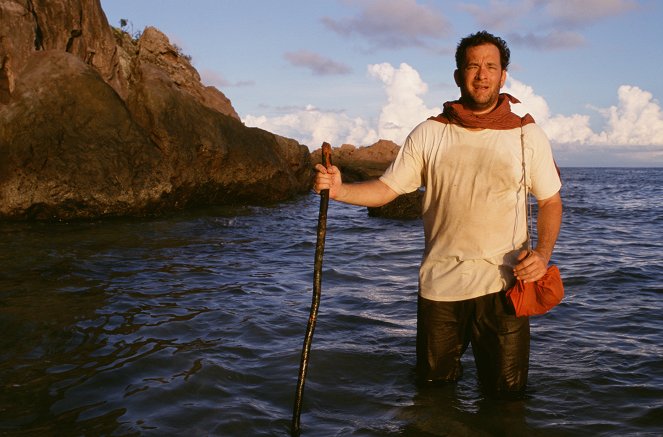
Adventure TV series
In the 1950s, Great Britain was particularly prolific in the production of adventure series for TV, with The Adventures of Robin Hood (1955-1960) becoming a success in the USA. During that time, the British also produced the series The Adventures of Sir Lancelot (1956-1957) and The Count of Monte Cristo (1956), the pirate series The Buccaneers (1956-1957), and William Tell (1958-1959), while the American series Zorro (1957-1959), Adventures in Paradise (1959-1962), and the family series Jeff's Collie (1954-1974) are also worth mentioning. The category of family adventure series grew in the 1960s with, for instance, Flipper (1964-1967) and the French Belle and Sebastian (1965-1970), but otherwise adventure stories tended to recede in favour of other genres. In the 1970s and 80s, the adventure genre was enriched by the miniseries Two Year's Vacation (1974), The Count of Monte Cristo (1979), The Coral Island (1983), Robin of Sherwood (1984-1986), and Crossbow (1987-1989). The adventure genre also included animated series such as Lupin Sansei (1971-1972), Around the World with Willy Fog (1981), DuckTales (1987-1990), and Chip 'n Dale Rescue Rangers (1989-1990).
In the 1990s, the development of digital technology led to the creation of several fantasy adventure series inspired by stories of legendary warriors and mythological heroes, the most famous of which were Hercules: The Legendary Journeys (1995-1999) and Xena: Warrior Princess (1995-2001), but the Canadian series The Adventures of Sinbad (1996-1998) also had many fans. Swashbuckling was revived in the series Zorro (1990-1993) and the miniseries The Count of Monte Cristo (1998) and The Scarlet Pimpernel (1999), while The Young Indiana Jones Chronicles (1992-1993) rode on the popularity of the adventure franchise, and Sharpe (1993-2008), which depicted the fate of a British soldier during the Napoleonic Wars, was also successful. The animated adventure genre grew with series such TaleSpin (1990-1991) and The Adventures of Tintin (1991-1992). Lost (2004-2010) became a phenomenon in the new millennium, depicting the adventurous lives of people who ended up as castaways on a mysterious island after a plane crash. Other significant milestones in the genre were the fantasy-adventure series Game of Thrones (2011-2019) and The Witcher (since 2019). There were other successful additions such as Arthurian series Merlin (2008-2012), the pirate series Black Sails (2014-2017), the historical series Spartacus (2010-2013), Marco Polo (2014-2016) and Vikings (2013-2020), the comic-book series Arrow (2012-2020), the miniseries Klondike (2014), and the animated series Dragons (2012-2014) and DuckTales (since 2017).
Filmmaniak









